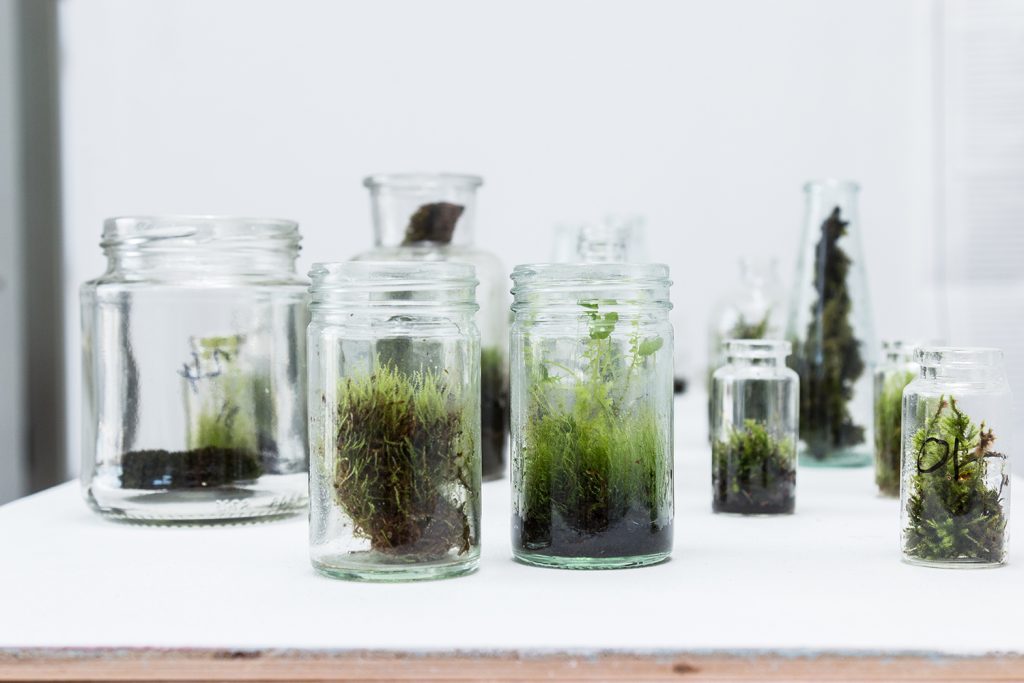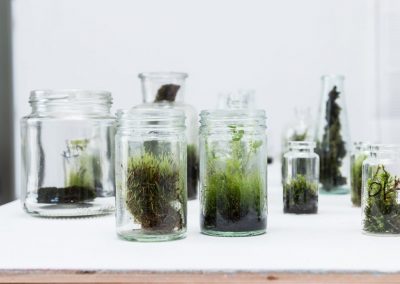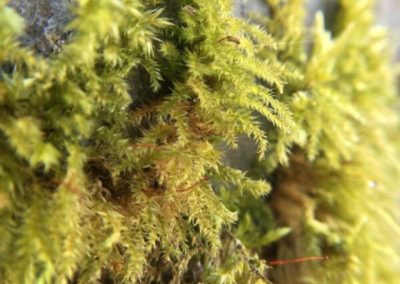
Antony Hall’s art residency at Gallery Oldham
NWCDTP-funded researcher Tony Hall talks about his artistic residency at Gallery Oldham, where he explored the secret life of moss to raise awareness of the unseen nature in the local environment and to discuss climate change.
During my three month placement with Gallery Oldham (April-July 2021), I worked with the curator of natural history Patricia Francis to create new artwork and a series of writings and workshops related to the bryophyte specimens (mosses and liverworts) and recollect new moss samples.
Bryophytes are an ancient family of amazingly resilient yet small plants, living fossils that are ecologically important in carbon capture and biodiversity (especially significant in hills surrounding Oldham). Much of the work behind the scenes with the natural history collection (collecting, cataloguing, and identifying specimens) relies on help from volunteers and enthusiastic amateurs. Most of the bryophytes were collected in the late 1800s by James Neild, a geologist and local businessman. His great great granddaughter Sue Willington currently volunteers behind the scenes helping to catalogue this vast collection.
Image 1: Glass Lantern Slide of James Nield sat in the Fossil Forest at Oldham Edge 1879, Gallery Oldham Collection.
Image 2 and 3: Bryophyte Specimens at Gallery Oldham
The mosses are stored as dry materials in small paper envelopes labelled with beautiful handwriting. Bryologists remove small fronds of the moss and rehydrated them with a drop of water under the microscope. It was fascinating to see the dry moss appear to come back to life after so many years in storage. This experience led me to make a series of videos of the moss rehydrating in the natural environment, which led in turn to an unexpected finding: I placed sensitive microphones into the moss and found that that the moss makes a crackling sound as it rehydrated, as well as recording the sounds of soil-dwelling insects (Listen to the sound of moss here).
Film [MP4] Time lapse loop of moss rehydrating. See more here http://antonyhall.net/blog/moss-re-hydration/
A highlight of this project was working with bryologist Anthony Gregory, a volunteer responsible for identifying bryophyte specimens that enter the collection. Our short two-mile riverside walk in the pouring rain took all morning. I learned the value of slowing down, bringing a minimal kit [just paper, a pencil and a hand lens] to focus on the smallest details. We collected over 20 different species just on that walk. As I learned more about mosses through the project, I eventually collected over 50 species.
Throughout the placement, I created a series of blogposts, tutorials and walking maps that I shared via Gallery Oldham’s blog and Instagram. See all the content developed here: http://antonyhall.net/blog/mossbothering/
Beyond the specificity of the project, the critical impact of this placement are the changes in my perception of the environment. I now think of my locality as a resource for my practice, and I have turned working focus towards ecological and environmental themes, for example by leading walking workshops (Radical urban bryology micro-navigations) with small groups. The project has also formed the basis for a new climate change awareness project called ‘Field Station,’ a mobile resource and series of workshops commissioned for Manchester Art Gallery. This in turn has led to new collaborations with ecologists and materials scientists and many new ideas for potential new project and funding bids.
Antony Hall is completing his PhD in the field of art and experimental psychology, exploring multisensory perceptual illusion at MMU. He is an interdisciplinary artist and educator who creates installations and workshops inspired by science. Recent works have used fluid mechanics, light, kinetic energy, and electrogenic fish, to create multimedia installations. He has exhibited and performed internationally and undertaken numerous commissions. Antony was a resident artist at UMISTs Fluid Mechanics Lab 2001-04, Manchester Natural History Museum 2005 and Loughborough Universities Underwater Acoustics Laboratory 2009. He is also a member of Owl Project collective who are known for work which intersects craft and technology and of Proximity collective, a group of 6 artists interested in the spatial and social elements of practice-as-research. www.antonyhall.net/blog
This project was completed as part the NWCDTP Researcher Led Placement scheme, with funding from the NWCDTP. You can read more about Tony’s PhD Placement here.



0 Comments